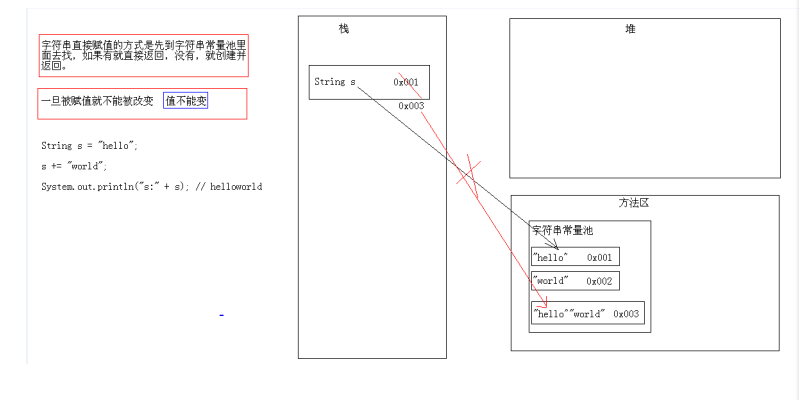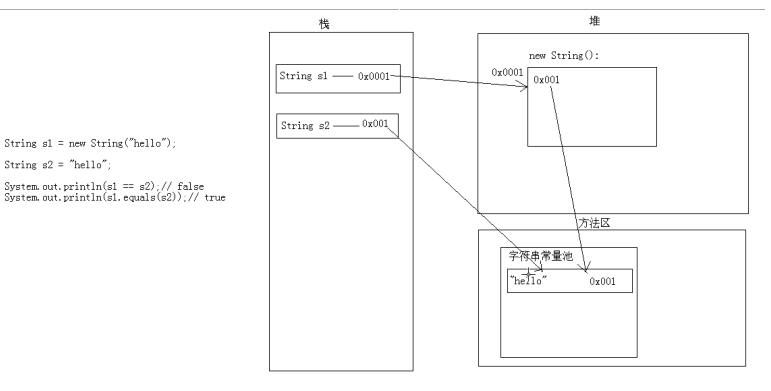Scanner類概述及其構造方法
名稱格式day天數_scanner
Scanner類概述及其構造方法
Scanner類概述
JDK5以後用於獲取使用者的鍵盤輸入
構造方法
public Scanner(InputStream source)
基本格式
hasNextXxx() 判斷是否還有下一個輸入項,其中Xxx可以是Int,Double等。如果需要判斷是否包含下一個字串,則可以省略Xxx
nextXxx() 獲取下一個輸入項。Xxx的含義和上個方法中的Xxx相同
預設情況下,Scanner使用空格,回車等作為分隔符
常用方法
public int nextInt()
public String nextLine()
package cn.it18zhang_01;
/*
* Scanner:用於接收鍵盤錄入資料。
*
* 前面的時候:
* A:導包
* B:建立物件
* C:呼叫方法
*
* System類下有一個靜態的欄位:
* public static final InputStream in; 標準的輸入流,對應著鍵盤錄入。
*
* InputStream is = System.in;
*
* class Demo {
* public static final int x = 10;
* public static final Student s = new Student();
* }
* int y = Demo.x;
* Student s = Demo.s;
*
*
* 構造方法:
* Scanner(InputStream source)
*/
import java.util.Scanner;
public class ScannerDemo {
public static void main(String[] args) {
// 建立物件
Scanner sc = new Scanner(System.in);
int x = sc.nextInt();
System.out.println("x:" + x);
}
}
案例二
package cn.itcast_02;
import java.util.Scanner;
/*
* 基本格式:
* public boolean hasNextXxx():判斷是否是某種型別的元素
* public Xxx nextXxx():獲取該元素
*
* 舉例:用int型別的方法舉例
* public boolean hasNextInt()
* public int nextInt()
*
* 注意:
* InputMismatchException:輸入的和你想要的不匹配
*/
public class ScannerDemo {
public static void main(String[] args) {
// 建立物件
Scanner sc = new Scanner(System.in);
// 獲取資料
if (sc.hasNextInt()) {
int x = sc.nextInt();
System.out.println("x:" + x);
} else {
System.out.println("你輸入的資料有誤");
}
}
}
String類概述及其構造方法
字串是由多個字元組成的一串資料(字元序列)
字串可以看成是字元陣列
構造方法
public String()
public String(byte[] bytes)
public String(byte[] bytes,int offset,int length)
public String(char[] value)
public String(char[] value,int offset,int count)
public String(String original)
package com.it18zhang_01;
/*
* 字串:就是由多個字元組成的一串資料。也可以看成是一個字元陣列。
* 通過檢視API,我們可以知道
* A:字串字面值"abc"也可以看成是一個字串物件。
* B:字串是常量,一旦被賦值,就不能被改變。
*
* 構造方法:
* public String():空構造
*public String(byte[] bytes):把位元組陣列轉成字串
*public String(byte[] bytes,int index,int length):把位元組陣列的一部分轉成字串
*public String(char[] value):把字元陣列轉成字串
*public String(char[] value,int index,int count):把字元陣列的一部分轉成字串
*public String(String original):把字串常量值轉成字串
*
* 字串的方法:
* public int length():返回此字串的長度。
*/
public class StringDemo {
public static void main(String[] args) {
// public String():空構造
String s1 = new String();
System.out.println("s1:" + s1);
System.out.println("s1.length():" + s1.length());
System.out.println("--------------------------");
// public String(byte[] bytes):把位元組陣列轉成字串
byte[] bys = { 97, 98, 99, 100, 101 };
String s2 = new String(bys);
System.out.println("s2:" + s2);
System.out.println("s2.length():" + s2.length());
System.out.println("--------------------------");
// public String(byte[] bytes,int index,int length):把位元組陣列的一部分轉成字串
// 我想得到字串"bcd"
String s3 = new String(bys, 1, 3);
System.out.println("s3:" + s3);
System.out.println("s3.length():" + s3.length());
System.out.println("--------------------------");
// public String(char[] value):把字元陣列轉成字串
char[] chs = { 'a', 'b', 'c', 'd', 'e', '愛', '林', '親' };
String s4 = new String(chs);
System.out.println("s4:" + s4);
System.out.println("s4.length():" + s4.length());
System.out.println("--------------------------");
// public String(char[] value,int index,int count):把字元陣列的一部分轉成字串
String s5 = new String(chs, 2, 4);
System.out.println("s5:" + s5);
System.out.println("s5.length():" + s5.length());
System.out.println("--------------------------");
//public String(String original):把字串常量值轉成字串
String s6 = new String("abcde");
System.out.println("s6:" + s6);
System.out.println("s6.length():" + s6.length());
System.out.println("--------------------------");
//字串字面值"abc"也可以看成是一個字串物件。
String s7 = "abcde";
System.out.println("s7:"+s7);
System.out.println("s7.length():"+s7.length());
}
}
String類的特點
字串是常量,它的值在建立之後不能更改
String s = “hello”; s += “world”; 問s的結果是多少?
package cn.it18zhang_02;
/*
* 字串的特點:一旦被賦值,就不能改變。
*/
public class StringDemo {
public static void main(String[] args) {
String s = "hello";
s += "world";
System.out.println("s:" + s); // helloworld
}
}
原理圖:
面試題
String s = new String(“hello”)和String s = “hello”;的區別?
package cn.it18zhang_02;
/*
* String s = new String(“hello”)和String s = “hello”;的區別?
* 有。前者會建立2個物件,後者建立1個物件。
*
* ==:比較引用型別比較的是地址值是否相同
* equals:比較引用型別預設也是比較地址值是否相同,而String類重寫了equals()方法,比較的是內容是否相同。
*/
public class StringDemo2 {
public static void main(String[] args) {
String s1 = new String("hello");
String s2 = "hello";
System.out.println(s1 == s2);// false
System.out.println(s1.equals(s2));// true
}
}
面試題:
package cn.it18zhang_02;
/*
* 看程式寫結果
*/
public class StringDemo3 {
public static void main(String[] args) {
String s1 = new String("hello");
String s2 = new String("hello");
System.out.println(s1 == s2);// false
System.out.println(s1.equals(s2));// true
String s3 = new String("hello");
String s4 = "hello";
System.out.println(s3 == s4);// false
System.out.println(s3.equals(s4));// true
String s5 = "hello";
String s6 = "hello";
System.out.println(s5 == s6);// true
System.out.println(s5.equals(s6));// true
}
}
面試題二:
package cn.it18zhang_02;
/*
* 看程式寫結果
* 字串如果是變數相加,先開空間,在拼接。
* 字串如果是常量相加,是先加,然後在常量池找,如果有就直接返回,否則,就建立。
*/
public class StringDemo4 {
public static void main(String[] args) {
String s1 = "hello";
String s2 = "world";
String s3 = "helloworld";
System.out.println(s3 == s1 + s2);// false
System.out.println(s3.equals((s1 + s2)));// true
System.out.println(s3 == "hello" + "world");// false 這個我們錯了,應該是true
System.out.println(s3.equals("hello" + "world"));// true
// 通過反編譯看原始碼,我們知道這裡已經做好了處理。
// System.out.println(s3 == "helloworld");
// System.out.println(s3.equals("helloworld"));
}
}
String類的判斷功能
boolean equals(Object obj)
boolean equalsIgnoreCase(String str)
boolean contains(String str)
boolean startsWith(String str)
boolean endsWith(String str)
boolean isEmpty()
package cn.it18zhang_03;
/*
* String類的判斷功能:
* boolean equals(Object obj):比較字串的內容是否相同,區分大小寫
* boolean equalsIgnoreCase(String str):比較字串的內容是否相同,忽略大小寫
* boolean contains(String str):判斷大字串中是否包含小字串
* boolean startsWith(String str):判斷字串是否以某個指定的字串開頭
* boolean endsWith(String str):判斷字串是否以某個指定的字串結尾
* boolean isEmpty():判斷字串是否為空。
*
* 注意:
* 字串內容為空和字串物件為空。
* String s = "";
* String s = null;
*/
public class StringDemo {
public static void main(String[] args) {
// 建立字串物件
String s1 = "helloworld";
String s2 = "helloworld";
String s3 = "HelloWorld";
// boolean equals(Object obj):比較字串的內容是否相同,區分大小寫
System.out.println("equals:" + s1.equals(s2));
System.out.println("equals:" + s1.equals(s3));
System.out.println("-----------------------");
// boolean equalsIgnoreCase(String str):比較字串的內容是否相同,忽略大小寫
System.out.println("equals:" + s1.equalsIgnoreCase(s2));
System.out.println("equals:" + s1.equalsIgnoreCase(s3));
System.out.println("-----------------------");
// boolean contains(String str):判斷大字串中是否包含小字串
System.out.println("contains:" + s1.contains("hello"));
System.out.println("contains:" + s1.contains("hw"));
System.out.println("-----------------------");
// boolean startsWith(String str):判斷字串是否以某個指定的字串開頭
System.out.println("startsWith:" + s1.startsWith("h"));
System.out.println("startsWith:" + s1.startsWith("hello"));
System.out.println("startsWith:" + s1.startsWith("world"));
System.out.println("-----------------------");
// 練習:boolean endsWith(String str):判斷字串是否以某個指定的字串結尾這個自己玩
// boolean isEmpty():判斷字串是否為空。
System.out.println("isEmpty:" + s1.isEmpty());
String s4 = "";
String s5 = null;
System.out.println("isEmpty:" + s4.isEmpty());
// NullPointerException
// s5物件都不存在,所以不能呼叫方法,空指標異常
System.out.println("isEmpty:" + s5.isEmpty());
}
}
模擬登入,給三次機會,並提示還有幾次。
package cn.it18zhang_03;
import java.util.Scanner;
/*
* 模擬登入,給三次機會,並提示還有幾次。如果登入成功,就可以玩猜數字小遊戲了。
*
* 分析:
* A:定義使用者名稱和密碼。已存在的。
* B:鍵盤錄入使用者名稱和密碼。
* C:比較使用者名稱和密碼。
* 如果都相同,則登入成功
* 如果有一個不同,則登入失敗
* D:給三次機會,用迴圈改進,最好用for迴圈。
*/
public class StringTest2 {
public static void main(String[] args) {
// 定義使用者名稱和密碼。已存在的。
String username = "admin";
String password = "admin";
// 給三次機會,用迴圈改進,最好用for迴圈。
for (int x = 0; x < 3; x++) {
// x=0,1,2
// 鍵盤錄入使用者名稱和密碼。
Scanner sc = new Scanner(System.in);
System.out.println("請輸入使用者名稱:");
String name = sc.nextLine();
System.out.println("請輸入密碼:");
String pwd = sc.nextLine();
// 比較使用者名稱和密碼。
if (name.equals(username) && pwd.equals(password)) {
// 如果都相同,則登入成功
System.out.println("登入成功,開始玩遊戲");
//猜數字遊戲
GuessNumberGame.start();
break;
} else {
// 如果有一個不同,則登入失敗
// 2,1,0
// 如果是第0次,應該換一種提示
if ((2 - x) == 0) {
System.out.println("帳號被鎖定,請與班長聯絡");
} else {
System.out.println("登入失敗,你還有" + (2 - x) + "次機會");
}
}
}
}
}
package cn.it18zhang_03;
import java.util.Scanner;
/*
* 這時猜數字小遊戲的程式碼
*/
public class GuessNumberGame {
private GuessNumberGame() {
}
public static void start() {
// 產生一個隨機數
int number = (int) (Math.random() * 100) + 1;
while (true) {
// 鍵盤錄入資料
Scanner sc = new Scanner(System.in);
System.out.println("請輸入你要猜的資料(1-100):");
int guessNumber = sc.nextInt();
// 判斷
if (guessNumber > number) {
System.out.println("你猜的資料" + guessNumber + "大了");
} else if (guessNumber < number) {
System.out.println("你猜的資料" + guessNumber + "小了");
} else {
System.out.println("恭喜你,猜中了");
break;
}
}
}
}
String類的獲取功能
int length()
char charAt(int index)
int indexOf(int ch)
int indexOf(String str)
int indexOf(int ch,int fromIndex)
int indexOf(String str,int fromIndex)
String substring(int start)
String substring(int start,int end)
案例:
package cn.it18zhang_04;
/*
* String類的獲取功能
* int length():獲取字串的長度。
* char charAt(int index):獲取指定索引位置的字元
* int indexOf(int ch):返回指定字元在此字串中第一次出現處的索引。
* 為什麼這裡是int型別,而不是char型別?
* 原因是:'a'和97其實都可以代表'a'
* int indexOf(String str):返回指定字串在此字串中第一次出現處的索引。
* int indexOf(int ch,int fromIndex):返回指定字元在此字串中從指定位置後第一次出現處的索引。
* int indexOf(String str,int fromIndex):返回指定字串在此字串中從指定位置後第一次出現處的索引。
* String substring(int start):從指定位置開始擷取字串,預設到末尾。
* String substring(int start,int end):從指定位置開始到指定位置結束擷取字串。
*/
public class StringDemo {
public static void main(String[] args) {
// 定義一個字串物件
String s = "helloworld";
// int length():獲取字串的長度。
System.out.println("s.length:" + s.length());
System.out.println("----------------------");
// char charAt(int index):獲取指定索引位置的字元
System.out.println("charAt:" + s.charAt(7));
System.out.println("----------------------");
// int indexOf(int ch):返回指定字元在此字串中第一次出現處的索引。
System.out.println("indexOf:" + s.indexOf('l'));
System.out.println("----------------------");
// int indexOf(String str):返回指定字串在此字串中第一次出現處的索引。
System.out.println("indexOf:" + s.indexOf("owo"));
System.out.println("----------------------");
// int indexOf(int ch,int fromIndex):返回指定字元在此字串中從指定位置後第一次出現處的索引。
System.out.println("indexOf:" + s.indexOf('l', 4));
System.out.println("indexOf:" + s.indexOf('k', 4)); // -1
System.out.println("indexOf:" + s.indexOf('l', 40)); // -1
System.out.println("----------------------");
// 自己練習:int indexOf(String str,int
// fromIndex):返回指定字串在此字串中從指定位置後第一次出現處的索引。
// String substring(int start):從指定位置開始擷取字串,預設到末尾。包含start這個索引
System.out.println("substring:" + s.substring(5));
System.out.println("substring:" + s.substring(0));
System.out.println("----------------------");
// String substring(int start,int
// end):從指定位置開始到指定位置結束擷取字串。包括start索引但是不包end索引
System.out.println("substring:" + s.substring(3, 8));
System.out.println("substring:" + s.substring(0, s.length()));
}
}
遍歷獲取字串中的每一個字元
package cn.it18zhang_04;
/*
* 需求:遍歷獲取字串中的每一個字元
*
* 分析:
* A:如何能夠拿到每一個字元呢?
* char charAt(int index)
* B:我怎麼知道字元到底有多少個呢?
* int length()
*/
public class StringTest {
public static void main(String[] args) {
// 定義字串
String s = "helloworld";
// 原始版本
// System.out.println(s.charAt(0));
// System.out.println(s.charAt(1));
// System.out.println(s.charAt(2));
// System.out.println(s.charAt(3));
// System.out.println(s.charAt(4));
// System.out.println(s.charAt(5));
// System.out.println(s.charAt(6));
// System.out.println(s.charAt(7));
// System.out.println(s.charAt(8));
// System.out.println(s.charAt(9));
// 只需要我們從0取到9
// for (int x = 0; x < 10; x++) {
// System.out.println(s.charAt(x));
// }
// 如果長度特別長,我不可能去數,所以我們要用長度功能
for (int x = 0; x < s.length(); x++) {
// char ch = s.charAt(x);
// System.out.println(ch);
// 僅僅是輸出,我就直接輸出了
System.out.println(s.charAt(x));
}
}
}
統計一個字串中大寫字母字元,小寫字母字元,數字字元出現的次數。(不考慮其他字元)
package cn.it18zhang_04;
/*
* 需求:統計一個字串中大寫字母字元,小寫字母字元,數字字元出現的次數。(不考慮其他字元)
* 舉例:
* "Hello123World"
* 結果:
* 大寫字元:2個
* 小寫字元:8個
* 數字字元:3個
*
* 分析:
* 前提:字串要存在
* A:定義三個統計變數
* bigCount=0
* smallCount=0
* numberCount=0
* B:遍歷字串,得到每一個字元。
* length()和charAt()結合
* C:判斷該字元到底是屬於那種型別的
* 大:bigCount++
* 小:smallCount++
* 數字:numberCount++
*
* 這道題目的難點就是如何判斷某個字元是大的,還是小的,還是數字的。
* ASCII碼錶:
* 048
* A65
* a97
* 雖然,我們按照數字的這種比較是可以的,但是想多了,有比這還簡單的
* char ch = s.charAt(x);
*
* if(ch>='0' && ch<='9') numberCount++
* if(ch>='a' && ch<='z') smallCount++
* if(ch>='A' && ch<='Z') bigCount++
*D:輸出結果。
*
* 練習:把給定字串的方式,改進為鍵盤錄入字串的方式。
*/
public class StringTest2 {
public static void main(String[] args) {
//定義一個字串
String s = "Hello123World";
//定義三個統計變數
int bigCount = 0;
int smallCount = 0;
int numberCount = 0;
//遍歷字串,得到每一個字元。
for(int x=0; x<s.length(); x++){
char ch = s.charAt(x);
//判斷該字元到底是屬於那種型別的
if(ch>='a' && ch<='z'){
smallCount++;
}else if(ch>='A' && ch<='Z'){
bigCount++;
}else if(ch>='0' && ch<='9'){
numberCount++;
}
}
//輸出結果。
System.out.println("大寫字母"+bigCount+"個");
System.out.println("小寫字母"+smallCount+"個");
System.out.println("數字"+numberCount+"個");
}
}
String類的轉換功能
byte[] getBytes()
char[] toCharArray()
static String valueOf(char[] chs)
static String valueOf(int i)
String toLowerCase()
String toUpperCase()
String concat(String str)
package cn.itcast_05;
/*
* String的轉換功能:
* byte[] getBytes():把字串轉換為位元組陣列。
* char[] toCharArray():把字串轉換為字元陣列。
* static String valueOf(char[] chs):把字元陣列轉成字串。
* static String valueOf(int i):把int型別的資料轉成字串。
* 注意:String類的valueOf方法可以把任意型別的資料轉成字串。
* String toLowerCase():把字串轉成小寫。
* String toUpperCase():把字串轉成大寫。
* String concat(String str):把字串拼接。
*/
public class StringDemo {
public static void main(String[] args) {
// 定義一個字串物件
String s = "JavaSE";
// byte[] getBytes():把字串轉換為位元組陣列。


